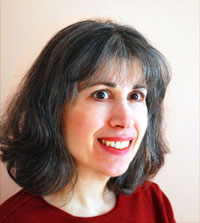How the Charlotte Mason Method Came to America
By Karen Andreola
Printed in Practical Homeschooling #101, 2011.
 The Charlotte Mason method has been around a long time. Here's how it got here.
The Charlotte Mason method has been around a long time. Here's how it got here.

|
 |
Once upon a time,
British educator Charlotte Mason (1842–1923) was not a household name with American
home educators. That was about to change.
It was midnight. The room was dark. I was sitting in a little pool of light
reading Home Education by Charlotte Mason. I had finally got hold of a rare copy
by way of London’s inter-library loan. I had been so intrigued by what I had
read (that winter of ’86) in Susan Schaeffer Macaulay’s book, For the Children’s
Sake, that I longed to read more. My children were young. We were Americans
living in the London suburbs far from the dawning homeschool movement back home.
Oh, how I longed for a copy of Home Education of my very own!
Thus began my husband, Dean’s, amazing quest.
In search of any and all books written by Miss Mason he telephoned every used
bookshop in Great Britain—to no avail. Dean even tracked down the last British
publisher of Miss Mason’s works and gave them a call. A salesman told him that
they had just relegated a warehouse full of Miss Mason’s books to the “bin” due
to lack of sales. “If only you would’ve called two weeks ago I could’ve sold
them to you cheap…we’ve been sitting on them since the 1950’s!”
Just as Dean was about to give up, an elderly shop owner told him, “Haven’t seen
any of Miss Mason’s works for years . . . but have you tried the Charlotte Mason
College?” A stunned silence followed. We were unaware that such a place existed.
A month later Dean was away on business for the Christian literature mission we
worked with. Travels north brought him near Scotland’s boarder and as Providence
would have it, the Lake District of England; home of Beatrix Potter, William
Wordsworth and . . . the Charlotte Mason College. After booking into a B&B in the
quaint village of Ambleside, he stepped into the college library and asked the
librarian to direct him to the works of Miss Charlotte Mason.
“Oh, we don’t keep them out here” he said, pointing to the shelves all around
the room. “Not much interest these days,” he whispered. “I’ll get the set out of
the vault if you care to sit with them a bit.” And sit Dean did for the next
several hours, wishing that I were beside him to enjoy the moment. Then he
hazarded to ask if he could borrow them. “It is the only complete set we have,
and they’re not for loan,” the librarian said.
Having come so far Dean was not ready to call it quits. He said, “Let me speak
to the college president.”
“He sees no one without an appointment,” came the reply.
“Tell him that I represent publishers in the USA who may wish to reprint these
books and I would be delighted if the president would consider writing the
forward.”
The librarian dialed the president’s office, turned to Dean and said, “Dr.
Thorley will see you in five minutes!”
Dean spent the next hour with cheerful, gracious Dr. John Thorley, a Greek
history scholar, who exhibited a rare enthusiasm for educational reform, and was
more than happy to give Dean a walking history of the school, a brief
biographical sketch of Miss Mason, and finally to Dean’s delight, a package
containing all six of Charlotte Mason’s rare out-of-print books.
Our mission term ended. We headed home with one of the only complete sets of
Miss Mason’s books. It was nestled securely in a flight bag (not a suitcase) as
Dean would not entrust them to airline baggage handlers.
Once back in the States, Dean was in communication with Christian publishers to
see who would take on the expensive and risky project of reprinting the entire
six volumes in a box set. After months of rejections a publisher was found, and
in 1989 The Original Homeschooling Series was published with Dr. Thorley’s
forward, as promised.
My years of endeavoring to learn it and live it followed. We started a CM home
group and mailed out a CM magazine. In the 1990s, I wrote articles for Practical
Homeschooling, did keynote speaking and in 1998 published The Charlotte Mason
Companion, making her ideas approachable to the modern teacher. A movement was
emerging. Today, by way of the Internet, many voices are propelling the message
around the globe.
What is it about Charlotte Mason’s principles of education that have attracted
such a following? Although a wider scope deserves to be mentioned, here are two.
A
Pearl of Great Price
As a young woman Miss Mason noticed that the methods of education in her day
(the intimidating Victorian schoolmaster for one) assume that a child has little
to no curiosity. Yet curiosity was the very first quality Miss Mason witnessed
in young children. How do we then secure a child’s attention to do his lessons?
It’s simple. We put into his hands (and heart) books that are interesting.
Curiosity is a little pearl of great value in education.
Living Books
Miss Mason noted that Great Britain could boast a wealth of literary genius, yet
the schoolbooks were as dry as dust. Rather than lecture, a teacher who followed
her method read aloud from books of literary quality, books that were alive with
ideas, books whose authors had a passion for their subject, some with a story
aspect to them. “Mind must come into contact with mind through the medium of
ideas,” she said.1 Ideas are found in living books. With a step of faith she
made these books the children’s schoolbooks.
The
Art of Knowing
Such vivifying books enabled her students to narrate what they read (after a
single reading). By their narration they were putting the reading in their own
words, “giving it forth again with just that little touch that comes from one’s
own mind” one of Miss Mason’s teachers said.2 Children narrated from their
lovely books, rather than exclusively recite from memorization, cram for tests
or stay up late with homework. Miss Mason called narration “the act of
knowing.”3 Her aim was knowledge for its own sake—not information crammed the
night before for a test and soon forgotten.
Narrating “demands a conscious mental effort from the scholar” Miss Mason said.4
With this method a child’s mind follows a train of thought, develops powers of
imagination, exercises verbal skills. It does the sorting, arranging, sequencing
for itself—those things a teacher’s lecture or a detailed workbook page
typically take responsibility for.
At the close of each term students would “sit for examinations.” They wrote
narrations in a composition book. Here they “talked about” certain points
brought forth from their lovely books.
The
Gentle Art Revived
Today this marvelous, simple, yet fortifying method is being employed with
freedom and success in America’s home schools. Books that are “living”
(interesting) abound in homeschool catalogs and public libraries for those who
look. And for those who have the courage to trust in the natural, God-given
curiosity within their student—a burden is lifted. A new and refreshing learning
experience awaits all who follow this method I came to call “the gentle art of
learning.”
Destiny
Charlotte Mason could not have known how her words would be enthusiastically
welcomed by tens of thousands of American families a century later. Thank you,
Susan Macaulay, for introducing us to Charlotte Mason. Thank you, Dean, for
finding Miss Mason’s writings and keeping them in print for more than twenty
years. Thank you, Mary Pride, for inviting me to write about the Charlotte Mason
Method in Practical Homeschooling.
By friend-tell-a-friend the Charlotte Mason movement has become widespread, and
in many cases the children of a second generation are benefiting. Your family
can benefit, too.
End Notes
1. A Philosophy of Education by Charlotte Mason, Charlotte Mason Research & Supply,
Quarryville, PA, page 39.
2. The Story of Charlotte Mason by Essex Cholmondeley PNEU, London, 1960, page 125.
3. Phil of Ed, Page 99. 4. Phil of Ed, page 159.